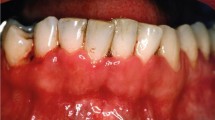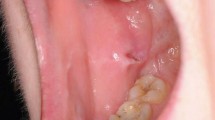Key Points
-
Oral ulcers are common
-
Aphthae may be precipitated by trauma
-
Ulcers rarely cause complications
-
Any ulcer which becomes increasingly painful or is persistent should be seen by a specialist
Abstract
Oral ulceration is a common oral mucosal disorder arising from a range of aetiologies but, apart from being associated with discomfort or pain, rarely results in complications apart from occasional scarring. This paper reports two patients with a history of minor aphthae who developed ulceration with increasingly severe pain, related to the onset of osteitis, and who then developed sequestrae.
Similar content being viewed by others
Main
Oral ulceration has many different causes, but recurrent aphthous stomatitis (RAS) is one of the more common.1,2,3,4 Ulcers, including RAS, apart from being associated with discomfort or pain, rarely result in complications.1,2,3,4 However, they may be persistent in some patients, particularly if major aphthae, and there may be scarring after major or herpetiform aphthae, but most minor aphthae resolve spontaneously in under 14 days or so.1,2,3,4
This paper reports two patients with a history of minor aphthous ulceration who developed severe pain related to osteitis and sequestrae resulting from overlying ulceration.
Cases
Case 1
This was a 45-year-old Caucasian male with a history of minor aphthous stomatitis, referred with severe persistent orofacial pain in the left posterior mandible for the previous 5 days.
The pain had arisen a few days following a session of scaling at his dental hygienist and had increased gradually in severity, necessitating analgesics. However, the pain had ameliorated somewhat a few hours prior to the consultation at the oral medicine clinic.
He had no other orofacial symptoms and his medical history was completely clear. He was a non-smoker and took alcohol only socially.
Examination revealed no extraoral abnormalities or cervical lymph node enlargement. Intraoral examination revealed a single round ulcer about 5 mm in diameter and resembling a minor aphthous ulcer, just inferior to the internal oblique ridge in the posterior left mandible. However, the ulcer surrounded a 3 mm whitish bony-hard disc. Indeed, the bony disc came loose with probing and, on examination, appeared consistent with a sequestrum – confirmed later histopathologically (Fig 1). It was assumed that the ulceration had caused an underlying osteitis with necrosis of a small area of cortical bone, which later sequestrated.
The pain resolved within hours and by one week the area had healed completely and the patient was pain-free.
Case 2
This was a 53-year-old Caucasian male dentist who developed severe persistent orofacial pain arising from the left posterior mandible but radiating over the left face. The pain was of spontaneous onset, increased gradually in severity, and appeared to originate from a solitary oral ulcer lingual to the third mandibular molar. He had a history of minor aphthous stomatitis though he had suffered rarely in the previous decade. He had no other orofacial symptoms and his medical history was completely clear. He was a non-smoker and took alcohol only socially.
Self-examination revealed no extraoral abnormalities or cervical lymph node enlargement. Intraoral examination revealed a single round ulcer about 5 mm in diameter just inferior to the internal oblique ridge in the posterior left mandible, with an inflammatory halo. This was treated symptomatically for 5 days with 0.2% aqueous chlorhexidine rinses to little avail, and pain was controlled with paracetamol (acetoaminophen) 500 mg qds. Although the ulcer did not change in size or severity of pain, it eventually became evident that the base was bony-hard. After 10 days the pain ameliorated and a yellowish-white bony hard disc about 4 mm in diameter exfoliated from the area and, on examination, appeared consistent with a sequestrum. The pain then resolved within hours and by one week the area had healed completely. In view of the very close similarity of features with case 1, it was assumed that both had had a similar aetiopathogenesis.
Discussion
Oral ulceration can arise from local causes such as trauma, malignant disease, systemic disease (infection or disorders of the blood, intestine or skin mainly) or from aphthae. Recurrent aphthous stomatitis (RAS) is a common oral mucosal disorder that may be initiated by trauma, and apart from being associated with discomfort or pain, results in few complications.1,2,3,4 Ulcers, particularly major aphthae, may persist in some patients, and there may be scarring after major or herpetiform aphthae, but most minor aphthae resolve spontaneously in around 7 to 14 days.1,2,3,4
The present paper reports two adult males who developed severe pain associated with ulceration consistent with minor aphthae affecting the lingual mandibular molar area, which had presumably been precipitated by trauma, a recognised precipitating factor in individuals predisposed to RAS. It is of course possible that the ulcers were traumatic rather than aphthous, since in both cases the ulcers were over the internal oblique ridge and there are no diagnostic tests to establish them as aphthae but, nevertheless, sequestration is still a rare consequence of oral ulceration. It is probable that the ulceration caused an underlying acute osteitis with subsequent necrosis of a small area of cortical bone, which later sequestrated, at which time the pain ameliorated and the ulcer healed.
References
Porter SR, Scully C, Pedersen A . Recurrent aphthous stomatitis. Crit Rev Oral Biol Med 1998; 9: 306–321.
Ship JA . Recurrent aphthous stomatitis: An update. Oral Surg Oral Med Oral Pathol Oral Radiol Endod 1996; 81: 141–147.
Woo SB, Sonis ST . Recurrent aphthous ulcers: A review of diagnosis and treatment. J Am Dent Assoc 1996; 127: 1202–1213.
Rogers RS 3rd . Recurrent aphthous stomatitis: clinical characteristics and associated systemic disorders. Semin Cutan Med Surg 1997; 16: 278–283.
Author information
Authors and Affiliations
Additional information
Refereed paper
Rights and permissions
About this article
Cite this article
Scully, C. Oral ulceration: a new and unusual complication. Br Dent J 192, 139–140 (2002). https://doi.org/10.1038/sj.bdj.4801315
Received:
Accepted:
Published:
Issue Date:
DOI: https://doi.org/10.1038/sj.bdj.4801315
This article is cited by
-
Current Understanding of the Pathophysiology of Osteonecrosis of the Jaw
Current Osteoporosis Reports (2018)
-
Oral surgery: Prominent bone shelves
British Dental Journal (2014)
-
Letters
British Dental Journal (2002)




